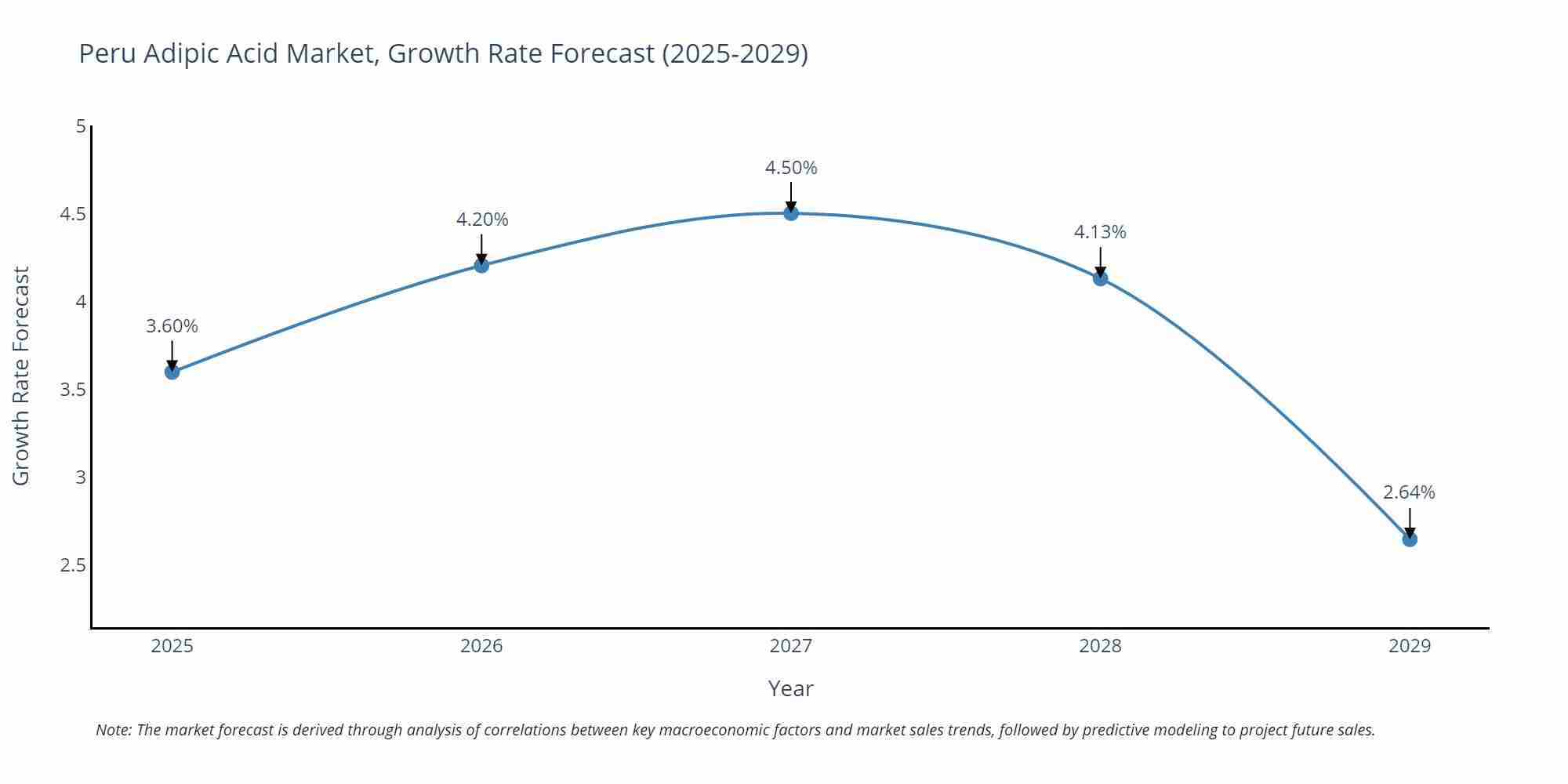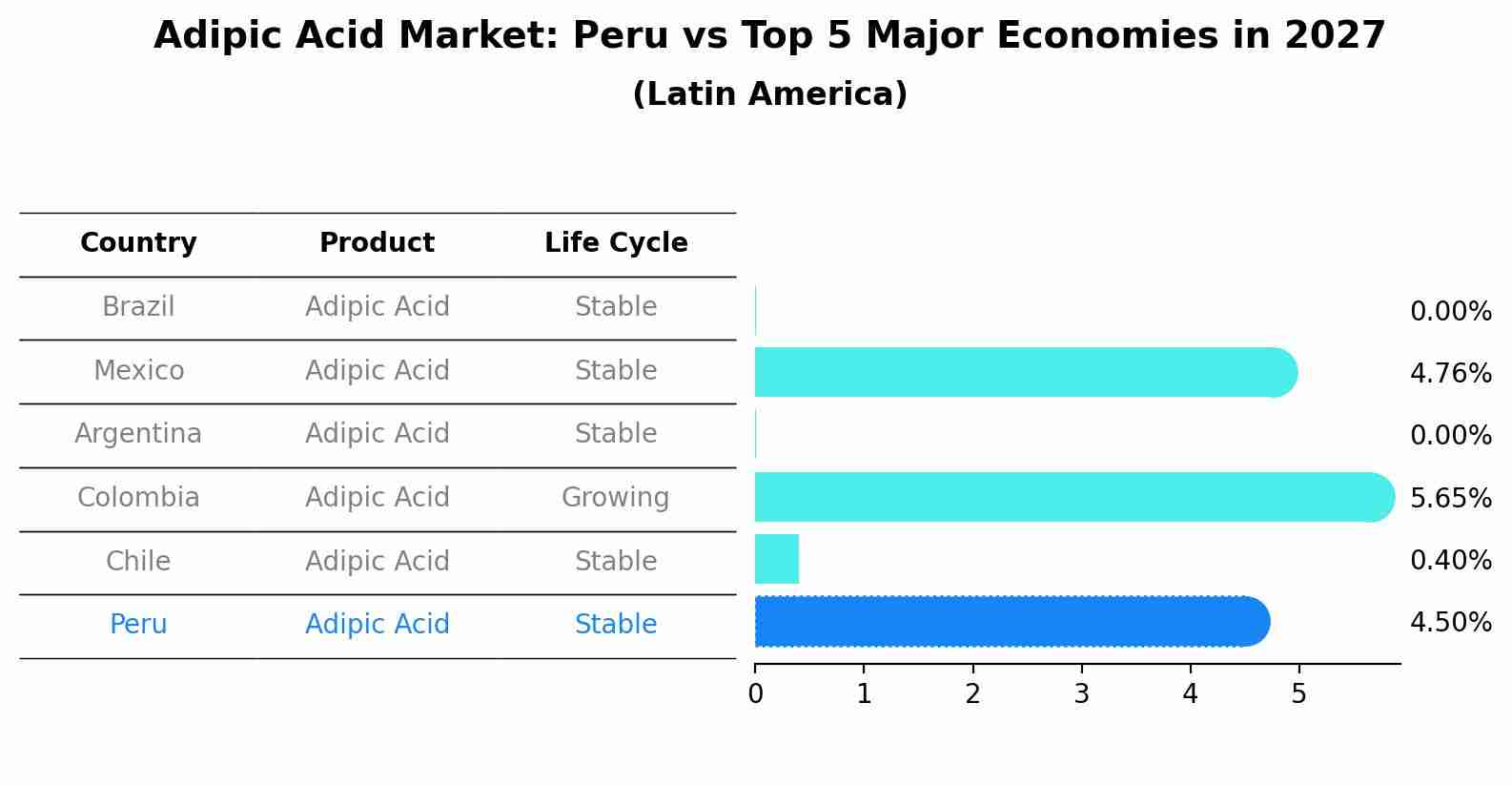Peru Adipic Acid Market Outlook | Share, Size, Growth, Analysis, Value, Industry, Trends, Forecast, Companies, COVID-19 IMPACT & Revenue
Market Forecast By Applications (Nylon 66, Plasticizers, Polyurethanes, Automotive, Polyester Staple Fiber) And Competitive Landscape
| Product Code: ETC192258 | Publication Date: May 2022 | Updated Date: Jun 2025 | Product Type: Market Research Report | |
| Publisher: 6Wresearch | Author: Vasudha | No. of Pages: 60 | No. of Figures: 40 | No. of Tables: 7 |
Peru Adipic Acid Market Size Growth Rate
The Peru Adipic Acid Market is projected to witness mixed growth rate patterns during 2025 to 2029. Starting at 3.60% in 2025, the market peaks at 4.50% in 2027, and settles at 2.64% by 2029.

Adipic Acid Market: Peru vs Top 5 Major Economies in 2027 (Latin America)
Peru's Adipic Acid market is anticipated to experience a stable growth rate of 4.50% by 2027, reflecting trends observed in the largest economy Brazil, followed by Mexico, Argentina, Colombia and Chile.

Peru Adipic Acid Market Overview
The Peru Adipic Acid Market is witnessing steady growth driven by increasing demand from industries such as automotive, textile, and packaging. Adipic acid is primarily used in the production of nylon, polyurethane resins, and as a food additive. The market is expected to continue expanding due to the rising disposable income, urbanization, and growing industrialization in the country. Key players in the Peru Adipic Acid Market include INVISTA, Ascend Performance Materials, and Asahi Kasei Corporation, among others. The market is also influenced by factors such as raw material prices, government regulations, and technological advancements. Overall, the Peru Adipic Acid Market presents promising opportunities for growth and investment in the coming years.
Peru Adipic Acid Market Trends
The Peru Adipic Acid market is experiencing steady growth driven by the increasing demand for nylon production in various industries such as automotive, textiles, and packaging. The market is also witnessing a shift towards more sustainable and eco-friendly production methods, with a focus on reducing carbon emissions and minimizing environmental impact. Additionally, the growing awareness about the benefits of adipic acid in enhancing the performance characteristics of end products is driving its adoption in various applications. Market players are also investing in research and development to develop innovative formulations and expand their product portfolios to cater to evolving consumer needs. Overall, the Peru Adipic Acid market is poised for continued growth in the coming years, supported by favorable market dynamics and increasing industrial applications.
Peru Adipic Acid Market Challenges
In the Peru Adipic Acid market, challenges primarily include fluctuating raw material prices, competition from alternative bio-based chemicals, and environmental concerns surrounding the production process. Adipic acid is traditionally derived from petrochemicals, making it susceptible to price volatility driven by global oil and gas markets. Additionally, the shift towards sustainable practices has led to increased demand for bio-based alternatives, posing a threat to the market share of traditional adipic acid producers. Moreover, the environmental impact of adipic acid production, particularly in terms of greenhouse gas emissions and waste generation, is a growing concern among consumers and regulatory bodies. Addressing these challenges will require market players to innovate sustainable production methods, invest in research and development for bio-based solutions, and adapt to changing consumer preferences for environmentally friendly products.
Peru Adipic Acid Market Investment Opportunities
The Peru Adipic Acid Market presents lucrative investment opportunities due to the country`s growing textile, automotive, and construction industries that are driving the demand for adipic acid, a key chemical used in the production of nylon and polyurethane. With increasing focus on sustainability and environmental regulations, there is a rising demand for bio-based adipic acid, creating opportunities for innovative companies to capitalize on this trend. Additionally, the government`s initiatives to attract foreign investments and promote industrial growth further enhance the market potential. Investing in adipic acid production facilities or partnering with local manufacturers to introduce eco-friendly alternatives can be strategic moves to tap into this expanding market and benefit from the growing industrial activities in Peru.
Peru Adipic Acid Market Government Policy
Government policies related to the Peru Adipic Acid Market primarily focus on promoting sustainable production practices, reducing environmental impact, and ensuring compliance with international standards. The Peruvian government has implemented regulations to support the adoption of green technologies, encourage investment in research and development, and promote the use of renewable resources in the production of adipic acid. Additionally, there are policies in place to monitor and control emissions, waste management, and overall environmental stewardship within the industry. These measures aim to enhance competitiveness, attract foreign investment, and position Peru as a responsible player in the global adipic acid market while also safeguarding the country`s natural resources and ecosystems.
Peru Adipic Acid Market Future Outlook
The future outlook for the Peru Adipic Acid Market appears to be positive, driven by factors such as increasing demand from end-use industries like automotive, textiles, and packaging. The growing emphasis on sustainability and environmental regulations is also expected to boost the market as adipic acid is a key component in the production of eco-friendly plastics and coatings. Additionally, the expanding chemical industry in Peru and the region`s economic growth are likely to create opportunities for market growth. However, challenges such as fluctuating raw material prices and competition from alternative products may pose some constraints. Overall, with the right strategic initiatives and focus on innovation, the Peru Adipic Acid Market is poised for steady growth in the coming years.
Key Highlights of the Report:
- Peru Adipic Acid Market Outlook
- Market Size of Peru Adipic Acid Market, 2021
- Forecast of Peru Adipic Acid Market, 2031
- Historical Data and Forecast of Peru Adipic Acid Revenues & Volume for the Period 2018 - 2031
- Peru Adipic Acid Market Trend Evolution
- Peru Adipic Acid Market Drivers and Challenges
- Peru Adipic Acid Price Trends
- Peru Adipic Acid Porter's Five Forces
- Peru Adipic Acid Industry Life Cycle
- Historical Data and Forecast of Peru Adipic Acid Market Revenues & Volume By Applications for the Period 2018 - 2031
- Historical Data and Forecast of Peru Adipic Acid Market Revenues & Volume By Nylon 66 for the Period 2018 - 2031
- Historical Data and Forecast of Peru Adipic Acid Market Revenues & Volume By Plasticizers for the Period 2018 - 2031
- Historical Data and Forecast of Peru Adipic Acid Market Revenues & Volume By Polyurethanes for the Period 2018 - 2031
- Historical Data and Forecast of Peru Adipic Acid Market Revenues & Volume By Automotive for the Period 2018 - 2031
- Historical Data and Forecast of Peru Adipic Acid Market Revenues & Volume By Polyester Staple Fiber for the Period 2018 - 2031
- Peru Adipic Acid Import Export Trade Statistics
- Market Opportunity Assessment By Applications
- Peru Adipic Acid Top Companies Market Share
- Peru Adipic Acid Competitive Benchmarking By Technical and Operational Parameters
- Peru Adipic Acid Company Profiles
- Peru Adipic Acid Key Strategic Recommendations
Frequently Asked Questions About the Market Study (FAQs):
| 1 Executive Summary |
| 2 Introduction |
| 2.1 Key Highlights of the Report |
| 2.2 Report Description |
| 2.3 Market Scope & Segmentation |
| 2.4 Research Methodology |
| 2.5 Assumptions |
| 3 Peru Adipic Acid Market Overview |
| 3.1 Peru Country Macro Economic Indicators |
| 3.2 Peru Adipic Acid Market Revenues & Volume, 2021 & 2031F |
| 3.3 Peru Adipic Acid Market - Industry Life Cycle |
| 3.4 Peru Adipic Acid Market - Porter's Five Forces |
| 3.5 Peru Adipic Acid Market Revenues & Volume Share, By Applications, 2021 & 2031F |
| 4 Peru Adipic Acid Market Dynamics |
| 4.1 Impact Analysis |
| 4.2 Market Drivers |
| 4.3 Market Restraints |
| 5 Peru Adipic Acid Market Trends |
| 6 Peru Adipic Acid Market, By Types |
| 6.1 Peru Adipic Acid Market, By Applications |
| 6.1.1 Overview and Analysis |
| 6.1.2 Peru Adipic Acid Market Revenues & Volume, By Applications, 2021-2031F |
| 6.1.3 Peru Adipic Acid Market Revenues & Volume, By Nylon 66, 2021-2031F |
| 6.1.4 Peru Adipic Acid Market Revenues & Volume, By Plasticizers, 2021-2031F |
| 6.1.5 Peru Adipic Acid Market Revenues & Volume, By Polyurethanes, 2021-2031F |
| 6.1.6 Peru Adipic Acid Market Revenues & Volume, By Automotive, 2021-2031F |
| 6.1.7 Peru Adipic Acid Market Revenues & Volume, By Polyester Staple Fiber, 2021-2031F |
| 7 Peru Adipic Acid Market Import-Export Trade Statistics |
| 7.1 Peru Adipic Acid Market Export to Major Countries |
| 7.2 Peru Adipic Acid Market Imports from Major Countries |
| 8 Peru Adipic Acid Market Key Performance Indicators |
| 9 Peru Adipic Acid Market - Opportunity Assessment |
| 9.1 Peru Adipic Acid Market Opportunity Assessment, By Applications, 2021 & 2031F |
| 10 Peru Adipic Acid Market - Competitive Landscape |
| 10.1 Peru Adipic Acid Market Revenue Share, By Companies, 2021 |
| 10.2 Peru Adipic Acid Market Competitive Benchmarking, By Operating and Technical Parameters |
| 11 Company Profiles |
| 12 Recommendations |
| 13 Disclaimer |
- Single User License$ 1,995
- Department License$ 2,400
- Site License$ 3,120
- Global License$ 3,795
Search
Related Reports
- Portugal Electronic Document Management Market (2025-2031) | Strategy, Consumer Insights, Analysis, Investment Trends, Opportunities, Growth, Size, Share, Industry, Revenue, Segments, Value, Segmentation, Supply, Forecast, Restraints, Outlook, Competition, Drivers, Trends, Demand, Pricing Analysis, Competitive, Strategic Insights, Companies, Challenges
- France Electronic Document Management Market (2025-2031) | Strategy, Consumer Insights, Analysis, Investment Trends, Opportunities, Growth, Size, Share, Industry, Revenue, Segments, Value, Segmentation, Supply, Forecast, Restraints, Outlook, Competition, Drivers, Trends, Demand, Pricing Analysis, Competitive, Strategic Insights, Companies, Challenges
- Portugal Occupational Health & Safety Services Market (2025-2031) | Strategy, Consumer Insights, Analysis, Investment Trends, Opportunities, Growth, Size, Share, Industry, Revenue, Segments, Value, Segmentation, Supply, Forecast, Restraints, Outlook, Competition, Drivers, Trends, Demand, Pricing Analysis, Competitive, Strategic Insights, Companies, Challenges
- Netherlands Occupational Health and Safety Services Market (2025-2031) | Strategy, Consumer Insights, Analysis, Investment Trends, Opportunities, Growth, Size, Share, Industry, Revenue, Segments, Value, Segmentation, Supply, Forecast, Restraints, Outlook, Competition, Drivers, Trends, Demand, Pricing Analysis, Competitive, Strategic Insights, Companies, Challenges
- Belgium and Luxembourg Facility Management Market (2025-2031) | Strategy, Consumer Insights, Analysis, Investment Trends, Opportunities, Growth, Size, Share, Industry, Revenue, Segments, Value, Segmentation, Supply, Forecast, Restraints, Outlook, Competition, Drivers, Trends, Demand, Pricing Analysis, Competitive, Strategic Insights, Companies, Challenges
- Russia Women Intimate Apparel Market (2025-2031) | Strategy, Consumer Insights, Analysis, Investment Trends, Opportunities, Growth, Size, Share, Industry, Revenue, Segments, Value, Segmentation, Supply, Forecast, Restraints, Outlook, Competition, Drivers, Trends, Demand, Pricing Analysis, Competitive, Strategic Insights, Companies, Challenges
- Africa Chocolate Market (2025-2031) | Size, Share, Trends, Growth, Revenue, Analysis, Forecast, industry & Outlook
- Global Hydroxychloroquine And Chloroquine Market (2025-2031) | Industry, Trends, Size, Outlook, Growth, Value, Companies, Revenue, Analysis, Share, Forecast
- Saudi Arabia Plant Maintenance Market (2025-2031) | Industry, Size, Growth, Revenue, Value, Companies, Forecast, Analysis, Share & Trends
- Taiwan Electric Truck Market (2025-2031) | Outlook, Industry, Revenue, Size, Forecast, Growth, Analysis, Share, Companies, Value & Trends
Industry Events and Analyst Meet
Our Clients
Whitepaper
- Middle East & Africa Commercial Security Market Click here to view more.
- Middle East & Africa Fire Safety Systems & Equipment Market Click here to view more.
- GCC Drone Market Click here to view more.
- Middle East Lighting Fixture Market Click here to view more.
- GCC Physical & Perimeter Security Market Click here to view more.
6WResearch In News
- Doha a strategic location for EV manufacturing hub: IPA Qatar
- Demand for luxury TVs surging in the GCC, says Samsung
- Empowering Growth: The Thriving Journey of Bangladesh’s Cable Industry
- Demand for luxury TVs surging in the GCC, says Samsung
- Video call with a traditional healer? Once unthinkable, it’s now common in South Africa
- Intelligent Buildings To Smooth GCC’s Path To Net Zero













